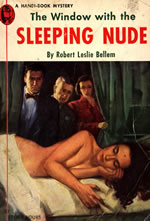The Window with the Sleeping Nude
 Cover Artist:
Cover Artist: not identified
By: Bellem, Robert Leslie
Publisher: Quinn Publishing Company, Inc. (Handi-Books)
Place of Publication:Kingston, New York
Catalog #: Kelley Box 196: PS3503 .E4438 W56 1950
Contributor:
K. Quinlivan
General
Era: 1950s
Author as on Cover: Robert Leslie Bellem
Publication:1950
Original Date: 1950
Setting: urban; interior of a large, thriving department store; apartments and cheap hotels in the surrounding area
Plot Summary
When Barney Cunard arrives at work one rainy morning, he is in no mood for jokes. All he wants is a chance to recover from the ill effects of a massive hangover. Unfortunately, his day begins with the discovery of a dead body in the front window of the department store where he works as an in-house detective. Much to Barney's dismay, the store's pompous owner and his equally obnoxious son hesitate about calling the police, but their delay soon spells more trouble when a second victim is located in a store workroom. Convinced that the store's owners have something to hide, and motivated by his desire to protect a beautiful fellow employee from harm, Barney launches into an action-packed search for the killer. In a romp through the department store that frequently borders on the comical, tough-talking Barney lets nothing stand in his way as he attempts to solve the case.
Major Characters
Barney Cunard adult male, big, strong, Arthur Godfrey look-alike, ex-cop turned store detective
Lieutenant Francis Lerch adult male, tall, cadaverous, cautious, impartial, homicide detective
Kitty Cavane adult female, early 20s, red hair, green eyes, snub nose, flirtatious department store clerk
Rodney Westervelt, Sr. white male, middle-aged, imperious, wealthy department store owner and city councilman
Rodney Westervelt, Jr. adult male, youngish, dapper, suntanned son of the department store owner
Percy Milton adult male, thin, artsy, effeminate, window dresser
Nora Gleason adult female, small, pretty, department store clerk
Martha Deayne adult female, tall, blonde hair, department store clerk
Peg Vollney adult female, dark hair, jewelry department manager
Mike Gleason adult middle aged male, "twinkling little Irishman", blue eyes, heavy brogue, night watchman
Angus MacCampbell adult male, short-tempered, taxi driver
Weapons
knives, gun
Level of Violence
Junior Westervelt is violent, hot-tempered, and has a reputation for beating up women, but this is tolerated due to his status and wealth. Cunard is hit on the head with a blunt instrument, two murder victims are stabbed to death, and one is shot with a .32 caliber handgun, but these incidents are mentioned only briefly. Overall, the novel's humorous tone makes light of most suggested threats and sudden rages.
Sexuality
plenty of sexual activity, ranging from vivid descriptions of women in tightly fitting dresses and slinky nylon stockings, to flirtatious store clerks who are eager for sexual adventures. Kitty is alternately portrayed as boldly asserting her sexuality and later coyly commenting that "I'm not that kind of girl." Junior Westervelt has slept with many of the store's female employees, discarding them in rapid succession.
Gender Roles
female characters are either sales clerks or secretaries in the store, and once they get married, they leave their jobs behind. They turn to men for sexual gratification and protection. The men are physically strong, but morally weak and emotionally insecure.
Ethnicity
the night watchman is the stereotypical Irish-American, hard-working but poor and sentimental. He speaks with a heavy brogue that is difficult to decipher at times. There is a reference to the murder weapon as a stiletto knife, which prompts one police detective to say, "You make it sound Eyetalian....that Dago stuff gives me the creeps."
Alcohol/Drug Abuse
the protagonist is no stranger to hard drinking, particularly during times of crisis, but this is not viewed as a weakness. Sleeping pills are mentioned briefly.
Law Enforcement
the police lieutenant is honest, competent and methodical, but not overly enthusiastic about his job. He respects the judgment of the store detective and is willing to listen to his theories about the case, but the lieutenant must also cope with political pressures, and has no desire to alienate the department store owner who also happens to be a bigwig on the city council. Two police officers in a patrol car are depicted as bumbling, inefficient, and foolish. In the final analysis, the police are always one step behind.
Added Features
big city department stores, like the one in this novel, have been replaced by suburban shopping plazas and mega-malls. Featuring caged elevators, pneumatic carrier systems, floorwalkers and errand boys, these multi-story buildings were the thriving retail centers that played a prominent role in the urban landscape of the 1950s.
The novel features a wide variety of '50s slang: "Gosh, Sherlock, you're swell!", "I think I seen a dame like that," "The murderer would have had time to lam from here to Alaska while everybody was bollixing around'" and "We've already got the squeal on those two bumps."
The store owners use their wealth and power to take advantage of their employees. They are convinced that their social status entitles them to use whatever methods they please to gratify their desires.
Subject Headings
Murder/ Detectives, Private/ Stores/ Police
Psychological Elements
Barney continually berates himself for just about everything that happens, from feeling guilty about drinking too much to not solving the case quickly enough.
 Cover Artist: not identified
Cover Artist: not identified